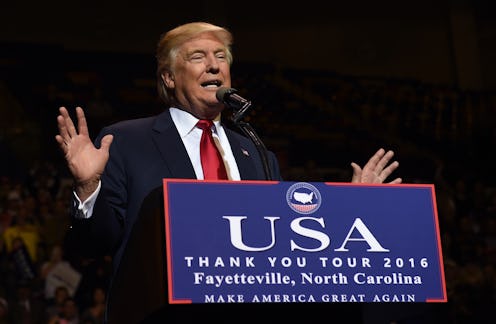News
'TIME's Trump Profile Is Unsettlingly Familiar
Whenever anyone is named TIME's Person of the Year, as President-elect Donald Trump was Wednesday morning, that person's detractors are quick to point out that the TIME distinction is not necessarily an honor. These detractors often point out that Adolf Hitler was once named to the same title. Out of curiosity, I reread TIME's 1938 cover story naming Hitler Person of the Year, which details Hitler's career at that point and describes the mood of the German populace that elected him. To my surprise, the language TIME used to describe Trump's ascent and Hitler's was stunningly similar.
First and foremost, I realize that it is a cliche as old as Internet comment sections — Godwin's Law, it's called — that as online discussions continue, the possibility of someone raising a comparison to Adolf Hitler increases. That is not, by and large, what I intend to do here. I am not comparing Adolf Hitler, who was responsible for the murder of millions of people, to Donald Trump, who obviously has never committed or promoted genocide.
I intend only to compare the language used by TIME in its similar (i.e. PotY) coverage of two distinct men. The horrors of the Holocaust cannot be minimized by pedestrian comparisons to modern-day American politics. Indeed, the most horrifying portions of the TIME profile of Hitler are not its references to the demagoguery of his campaign or the cult of personality he inspired (two aspects in which the profiles are similar), but rather its references to Hitler's concentration camps for Jewish people, communists, and socialists.
As a student of politics and history, though, I know it can be useful to compare two dissimilar things, and so I intend to compare, not Trump and Hitler themselves, but rather the language used by a specific magazine, generations apart, to describe two discrete rises to power.
I reviewed two TIME profiles for Trump, the announcement of his PotY title, by Nancy Gibbs, and the profile itself, by Michael Scherer; the Hitler profile did not reference an individual author but was published in early 1939. As I described above, I was stricken by the linguistic similarities amongst the three pieces. For example, both sets of profiles noted each man's failure to win a majority of voters, yet wrote as if their ultimate victories nonetheless validated the strength of their movement. The profile of Hitler stated:
While still short of a majority, the vote was nevertheless impressive proof of the power of the man and his movement.
Similarly, TIME proclaimed in 2016 that Trump was "empowering a hidden electorate by mainstreaming its furies," while also noting Trump's popular vote loss in both in its announcement of Trump as PotY and in its runner-up profile of Clinton. These men may not have cracked 50 percent support, TIME seems to imply, but their movements are substantive and powerful anyway.
Perhaps even more tellingly, both profiles called the man in question a "demagogue" and cited that demagoguery as central to his ascent to power. From the Hitler piece:
The situation which gave rise to this demagogic, ignorant, desperate movement was inherent in the German Republic's birth and in the craving of large sections of the politically immature German people for strong, masterful leadership.
TIME's "demagogic, ignorant, desperate movement" has similarities to Gibbs' 2016 description of Trump's America:
For reminding America that demagoguery feeds on despair and that truth is only as powerful as the trust in those who speak it ... and for framing tomorrow’s political culture by demolishing yesterday’s, Donald Trump is TIME’s 2016 Person of the Year.
Gibbs even echoed the theme of ignorance from the Hitler piece by implying, above, that the Trump "movement" does not value or give power to the truth. Scherer's piece, too, proclaimed, "This is the method of a demagogue," beneath a black-and-white picture of Trump advisor Steve Bannon.
As for the apparent German craving "for strong, masterful leadership?" Echoed by Scherer's argument about what Clinton missed:
What she and her team never fully understood was the depth of the populism Trump was peddling, the idea that the elites were arrayed against regular people, and that he, the great man, the strong man, the offensive man, the disruptive man, the entertaining man, could remake the physics of an election.
TIME portrayed both men as being carried to electoral victory by seductive cults of personality. Hitler, TIME staff wrote, cultivated an image as a "mystic, abstemious, charismatic Führer."
Moreover, TIME described both personality cults as resonating with similar audiences: working-class people who felt left behind by the times. The Hitler profile argues that the Fuhrer "lifted the nation from post-War defeatism," citing high unemployment rates that were turned around by Hitler's aggressive policies. The profile describes German "shame" after the First World War turning to "pride" under Hitler's leadership.
Trump, of course, has no policies to cite, since he has not taken office yet, but TIME connected his victory to "households headed by people without college degrees" whose median incomes fell. For these working-class Trump supporters, Gibbs wrote "Trump’s victory represents a long-overdue rebuke to an entrenched and arrogant governing class."
However, I want to caution that TIME's use of similar language hardly dooms Trump to emulate Hitler. Indeed, a President Trump could exceed expectations and avoid divisiveness while in office, and could even be, to the surprise of many liberals, a good president. True, TIME Magazine describes Trump's rise and Hitler's in similar terms, but it's certainly possible — and Americans will have to hope — that the similarities end there.
